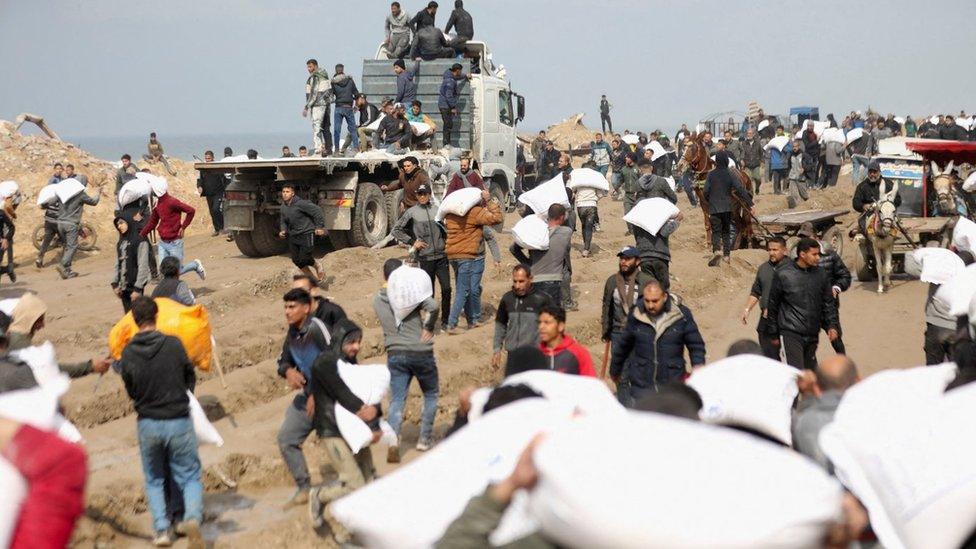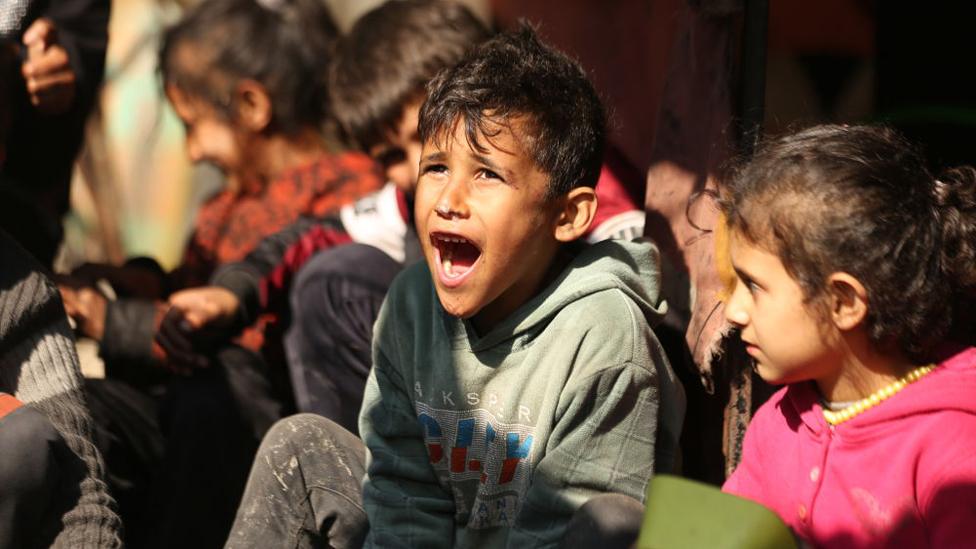Gaza aid airdrop: Why delivering food from the air is controversial
- Published
Watch: US cargo plane airdrops humanitarian aid into Gaza
The US says it airdropped 36,000 meals into northern Gaza on Tuesday in co-ordination with Jordan - the second such joint mission in recent days.
It came a day after the World Health Organization said children were dying of starvation in the north, where an estimated 300,000 Palestinians are living with little food or clean water.
But the strategy has sparked considerable discussion, with humanitarian organisations saying it cannot meet the soaring needs.
It is also a symbol of the failure of the aid effort on the ground.
Aid lorries have been entering the south of Gaza through the Egyptian-controlled Rafah crossing and the Israeli-controlled Kerem Shalom crossing during the war between Israel and Hamas. But the north, which was the focus of the first phase of the Israeli ground offensive, has been largely cut off from assistance in recent months.
On 20 February, the World Food Programme (WFP) said it was suspending food deliveries to northern Gaza because its first aid convoys in three weeks had endured "complete chaos and violence due to the collapse of civil order", including violent looting.
Last Thursday, more than 100 Palestinians were killed as crowds rushed to reach an aid convoy operated by private contractors that was being escorted by Israeli forces west of Gaza City.
Palestinian health officials said dozens were killed when Israeli forces opened fire. Israel's military said most died from either being trampled on or run over by the aid lorries. It said soldiers near the aid convoy had fired towards people who approached them and who they considered a threat.
But on Tuesday the WFP said it attempted to reach northern Gaza with food supplies today, but was "turned back" by the Israel Defense Forces (IDF). The IDF are yet to comment.
Israel's military launched an air and ground campaign in Gaza after Hamas's attacks on Israel on 7 October, in which around 1,200 people were killed and 253 others were taken hostage. More than 30,000 people have been killed in Gaza since then, the territory's Hamas-run health ministry says.
'Not enough'
More than 20 airdrops of aid into Gaza have taken place over the past few weeks in co-ordination with the Israeli military, with France, the United Arab Emirates and Egypt conducting them alongside the US and Jordan.
One Gaza resident, Ismail Mokbel, told BBC Arabic's Gaza Lifeline radio - an emergency radio service for the territory set up in response to the conflict - that packages of aid dropped on Friday consisted of some legumes and a few women's health essentials.

Desperate Palestinians have been surrounding convoys of lorries bringing food aid into northern Gaza
Another man, Abu Youssef, said he was not able to get some aid that was dropped near al-Shifa Hospital in Gaza City.
"Suddenly, when we were looking up into the sky, we saw aid parachutes. So we remained in the place [where we were] until the aid landed about 500 metres away from us. There were many people, but the aid was little, and so we could not get anything."
Mr Mokbel said not enough aid was dropped to meet the basic needs of the large number of people in the area.
"Thousands of citizens saw the aid falling on them... And when hundreds or thousands wait in such areas, only around 10 to 20 people get things, while the others go back with nothing. Unfortunately, this method of dropping through air is not the most suitable way to transport aid to the north district of Gaza," he added.
"Gaza needs a land and water pathway to deliver the aid instead of [doing it in] such a manner, which doesn't meet the needs of all citizens."
'Expensive and haphazard'
Initially employed during World War Two to supply isolated troops on the ground, airdrops have evolved into a valuable tool for delivering humanitarian aid, with the UN first using them in 1973.
However, they are considered a "last resort", only to be used "when more effective options fail", as the WFP said in a 2021 report. South Sudan is the last place where the WFP carried out airdrops.
"Airdrops are expensive, haphazard and usually lead to the wrong people getting the aid," Jan Egeland, the secretary general of the Norwegian Refugee Council and a former UN aid chief, told the BBC after returning from a recent three-day visit to Gaza.
Airdrops are seven times more expensive compared to ground-delivered aid due to costs related to aircraft, fuel and personnel, says the WFP.
In addition to that, only relatively small quantities can be delivered with each flight, in comparison to what a convoy of lorries can bring in, and significant ground co-ordination is required within the delivery zone, says the WFP.
Watch: US parachutes humanitarian aid into Gaza
The International Committee of the Red Cross also stresses the importance of controlling distribution to prevent people from risking their lives by consuming inappropriate or unsafe items.
"Delivering sudden and unsupervised types of food to people who are malnourished or even starving can pose serious risks to life. These risks need to be weighed against delivering nothing by air, or the delay a ground distribution may incur," the organisation warned in a 2016 report published when aid was being airdropped into Syria during the country's civil war.
Airdrops can be carried out from different altitudes, ranging from about 300m to 5,600m (985-18,370ft) in conflict zones, and so ensuring robust packaging is crucial to make sure parcels can endure impact with the ground, the WFP adds.
According to the agency, drop zones should ideally be large, open areas no smaller than a football field, which is why deliveries have often been aimed at Gaza's coastline.
However, this has sometimes resulted in aid falling into the sea or being carried by the wind into Israel, according to local accounts.
'US should pressure Israel'
Gaza resident Samir Abo Sabha told BBC Arabic's Gaza Lifeline radio that he believed the US should do more and put pressure on its ally Israel for a ceasefire.
"As a citizen of Gaza, this stuff is of no use," he said. "What we want [is] America to pressure Israel into a ceasefire and to stop giving Israel weapons and missiles."
Some aid workers have echoed this sentiment.
Last week, Scott Paul of Oxfam America wrote on X, formerly Twitter: "Instead of indiscriminate airdrops in Gaza, the US should cut the flow of weapons to Israel that are used in indiscriminate attacks, push for an immediate ceasefire and the release of hostages, and insist that Israel uphold its duty to provide humanitarian aid, access, and other basic services."
Melanie Ward of Medical Aid for Palestinians said the US, UK and others should "ensure that Israel immediately opens all crossings into Gaza for aid and aid workers to assist those in need".
But as the crisis deepens, others argued that food must be delivered by any means necessary.
"We need to bring food into Gaza any way we can. We should be bringing it by the sea," José Andrés, a chef and founder of World Central Kitchen, which has been sending food to Gaza, told ABC News.
"I don't think we need to be criticising that Jordan, America are doing airdrops. If anything, we should be applauding any initiative that brings food into Gaza."
President Biden has vowed that the US will "redouble our efforts to open a maritime corridor, and expand deliveries by land" - but those efforts have not yet translated into reality on the ground.
Israel Defense Forces spokesman Rear Admiral Daniel Hagari said on Sunday that they were facilitating aid convoys and airdrops to northern Gaza "because we want humanitarian aid to reach Gazan civilians in need".
"We will continue expanding our humanitarian efforts to the civilian population in Gaza while we fulfil our goals of freeing our hostages from Hamas and freeing Gaza from Hamas," he added.
Edited by Alexandra Fouché
- Published5 March 2024
